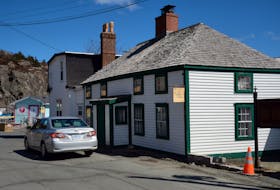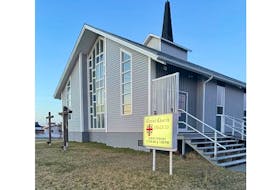Aboriginal people who attended a medicine talk at the ball field in St. George’s on Saturday learned the importance of some sacred plants.
“If you have a medicine that makes you feel good, what’s more powerful than that medicine?” Troy Bennett asked those in attendance during a talk on some of the sacred plants used by First Nations people.
Members of the Qalipu Mi’kmaq First Nation band joined the St. George’s Indian Band in celebrating National Aboriginal Day.
Bennett said tobacco is an important plant in all ceremonies and is also used when harvesting sweet grass. He said at that time a pinch of it should be offered to the Earth, as First Nations people are all about the earth.
The smoke from tobacco is also used in many other ceremonies.
Bennett encouraged fellow aboriginals to honour and cherish sweet grass. He said personally he uses sweet grass for ceremonial purposes only and that some people pick it to keep negativity out of the home.
He said prairie sage is also used a lot by people across the nation, especially women, to keep away negativity and to keep objects safe, as it’s a protection medicine. While sweet grass can be found in Newfoundland, sage is not native to this province.
Bennett said there are lots of plants that are very dangerous and only a true medicine person can tell you about the ones that can harm you.
However, he said one of the good ones is chaga, a mushroom that grows over the course of many years on the side of birch trees. He said chaga tea has been tested by aboriginal people and used by them for centuries for medicine and sacred purposes.
Bennett said cedar is a powerful medicine and is often used in a tea form. He said it’s a purifying medicine used in different ways, mostly by men.
“It crackles on the fire. Our people believe in a spiritual sense that this crackling draws our ancestors to come and join us. It’s very important,” he said.
Bennett said the low lying juniper is another plant used as a tea and it has the same properties and effects as the cedar.
“Its purpose to give thanks to the people that came here first as that’s where our background is,” he said. “With this medicine we also pray for our elders.”
Bennett also talked about the deer foot fungus, which is a mushroom type fungus that grows near the bottom of a birch tree and a spiritual medicine burned in honour of elders. Scrapings from the inside of this growth can be used to carry fires by devoted fire keepers.
He said the fungus, cedar and low lying juniper are all plentiful in this province.
Aboriginal people who attended a medicine talk at the ball field in St. George’s on Saturday learned the importance of some sacred plants.
“If you have a medicine that makes you feel good, what’s more powerful than that medicine?” Troy Bennett asked those in attendance during a talk on some of the sacred plants used by First Nations people.
Members of the Qalipu Mi’kmaq First Nation band joined the St. George’s Indian Band in celebrating National Aboriginal Day.
Bennett said tobacco is an important plant in all ceremonies and is also used when harvesting sweet grass. He said at that time a pinch of it should be offered to the Earth, as First Nations people are all about the earth.
The smoke from tobacco is also used in many other ceremonies.
Bennett encouraged fellow aboriginals to honour and cherish sweet grass. He said personally he uses sweet grass for ceremonial purposes only and that some people pick it to keep negativity out of the home.
He said prairie sage is also used a lot by people across the nation, especially women, to keep away negativity and to keep objects safe, as it’s a protection medicine. While sweet grass can be found in Newfoundland, sage is not native to this province.
Bennett said there are lots of plants that are very dangerous and only a true medicine person can tell you about the ones that can harm you.
However, he said one of the good ones is chaga, a mushroom that grows over the course of many years on the side of birch trees. He said chaga tea has been tested by aboriginal people and used by them for centuries for medicine and sacred purposes.
Bennett said cedar is a powerful medicine and is often used in a tea form. He said it’s a purifying medicine used in different ways, mostly by men.
“It crackles on the fire. Our people believe in a spiritual sense that this crackling draws our ancestors to come and join us. It’s very important,” he said.
Bennett said the low lying juniper is another plant used as a tea and it has the same properties and effects as the cedar.
“Its purpose to give thanks to the people that came here first as that’s where our background is,” he said. “With this medicine we also pray for our elders.”
Bennett also talked about the deer foot fungus, which is a mushroom type fungus that grows near the bottom of a birch tree and a spiritual medicine burned in honour of elders. Scrapings from the inside of this growth can be used to carry fires by devoted fire keepers.
He said the fungus, cedar and low lying juniper are all plentiful in this province.








